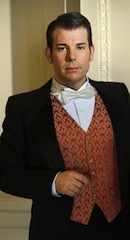
Panuccio's "O Holy Night" a Keeper
(first published at www.Cincinnati.com

Dec. 15, 2012) “O Holy Night,” tenor Marco Panuccio’s traveling Christmas show, demonstrated its staying power Friday night at St. Peter in Chains Cathedral.
Well over 300 “fanuccios” were present for the third reincarnation of the event since its inauguration in December 2010 at the neo-classic cathedral on Plum Street. It was the fourth stop on a five-state, six-city tour begun Dec. 2 in Shillington, Pa.
It was a deeply moving show, filled with vocal beauty and personal warmth. There were signature works from earlier years, “O Holy Night,” of course, which the young tenor first sang for local audiences on a Cincinnati Symphony “Home for the Holidays” concert in 1999. Also David Foster’s “Thankful,” dedicated to the world’s oldest Holocaust survivor (Alice Herz-Sommer, who turned 109 in November) and “Ave Marias” adapted from operatic excerpts by Jules Massenet and Pietro Mascagni.
There was even a Midwest premiere, British composer Gerald Finzi’s 1939 “Dies Natalis.”
Panuccio was accompanied by cathedral organist Blake Callahan, pianist Julie Spangler and an 18-piece chamber orchestra led by Isaac Selya. Performing offstage were sopranos Sarah Dorff-Schmid, Melissa Harvey and Amanda Heisler.
The concert was dedicated to the victims of the Newtown, Conn. massacre. The cathedral bell sounded 27 times in their memory before Panuccio sounded the first of three Gregorian chants during the show, “O Emmanuel,” echoed by the offstage sopranos.
The first half comprised sacred music and traditional carols. Panuccio opened with “Comfort Ye” and “Ev’ry Valley” from Handel’s “Messiah,” giving exquisite voice to the soft-spoken injunction and the hope-filled aria that follows. Selya and the orchestra provided a well-articulated accompaniment that dealt effectively with the cathedral’s reverberant acoustics.
Finzi’s work, a setting of verses by 17th-century metaphysical poet Thomas Traherne, unfolded in five movements, beginning with an orchestral introduction. The text voices the feelings of a newborn child experiencing the world for the first time. Panuccio, whose voice can be sweet and soft as a rose petal and bright a sunbeam, attended closely to word painting throughout (“The green trees . . . made my heart to leap”). There was unalloyed joy in “The Salutation” and “The Rapture” sparkled with dance-like energy. By contrast, “Wonder” was soft and reflective (“How like an angel came I down”).
After a sing along of “Hark the Herald Angels Sing” and a sparkling rendition of “Bring a Torch, Jeanette Isabella” by organist Callahan, Panuccio ended the first half with “Ave Maria” set to the Meditation from Massenet’s opera “Thaïs,” which gave concertmaster Nick Naegele a moment to shine.
Foster’s “Thankful” (popularized by Josh Groban) was followed by “Letter from Sullivan Ballou,” the real-life letter from a Civil War officer to his wife on the eve of battle, set to music by John Kander. Panuccio, accompanied by Spangler, put his best operatic expression into it, giving it a soft-breathed ending where Ballou speaks of his spirit caressing his wife Sarah’s cheek if he should die in battle.
Somewhat in the same vein, Panuccio followed with “I’ll Be Home for Christmas” (“if only in my dreams”) and by contrast, “It’s the Most Wonderful Time of the Year,” where Spangler reflected the hectic pace of the season with her nimble traversal of the piano keys. Panuccio returned to the sacred theme with selections from Hector Berlioz’ oratorio“L’enfance du Christ.” “Le Repos de la Saint Famille” tells of the Holy Family resting on their journey into Egypt. This touching music was beautifully crafted by Panuccio, Selya and the orchestra, with soft, sublime “Alleluias” at the end by the offstage sopranos.
Panuccio took up the baton to conduct the Trio for Two Flutes and Harp from part III of the work, a rare piece of chamber music by Berlioz, given a delightful reading by flutists Cleo Leung and Terence Teow and harpist Frances Cobb. The chant “Ave Maria” brought the sopranos to the center aisle, and Panuccio followed with “Ave Maria” set to the Intermezzo from Mascagni’s opera “Cavalleria rusticana.” Spangler’s prowess as an arranger was shown in a sing along of “Silent Night,” with the third stanza set for English horn and orchestra.
“O Holy Night” brought the program to a close, but not the music. Panuccio encored with another of his trademark pieces, “A Prayer to St. Catherine” by Virgil Thomson, a work sung in tribute to a deceased former voice teacher, who, said Panuccio, referring to the children who died at Newtown, Conn., “opened his arms today to all the children in Heaven.”
The lights in the cathedral went down for this and his final encore, the popular “Ave Maria” misattributed to Giulio Caccini. With organ, cathedral bells and sopranos in the balcony, it delivered a sensory and emotional wallop that summed up the entire concert.
After greeting well-wishers, Panuccio left for his final stop in Winter Park, Fla., where he repeats the show Dec. 21.